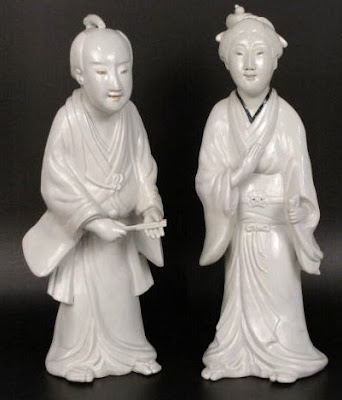 |
| photo: Durston Saylor Art Deco is timeless. This 2001 living room by Michael Rosenberg & Leonard Kowalski looks as chic today as the day it was designed. Courtesy of Architectural Digest. |
 |
| Long, lean lines abound in this Glenn Gissler designed, 1960s redux. |
 |
| A Jan Showers designed entrance hall. |
What is Art Deco? Art Deco is streamlined shapes and geometric figures. It is steel and lacquer, chrome and shagreen. It is the Chrysler Building, Rockefeller Center. It is elegant, sophisticated and timeless. It blends well (see the Bunny Williams living room in the previous post, in which she seamlessly blends Art Deco chairs with pieces from other eras). Where can you get Art Deco?
Glad you asked. Because I'm now about to let you in on a little secret. Now, I seriously hesitated to tell you about this, I must confess, even though I love you, my dearlings, I really do, because this auction house is, well... hands down, one of my absolute favorites, and not just mine; this "find" was discovered long ago by dealers and is routinely mined by them. The $1,200 chairs I saw online that later appeared for $8,400 at a Greenwich antiques dealer? They were from here. It's been discovered, but that doesn't mean it isn't still an amazing place for great deals. So...without further ado, I bring you several pieces of Art Deco, and I bring you Kamelot Auctions, in Philadelphia.
 |
| 1930s brass bed, at auction at Kamelot Auctions on June 11th, starting bid $500. Just email the auctioneer to make sure you understand all the dimensions. And don't be put off by odd shapes: custom made mattresses are cheaper than ever thanks to, I'm not kidding, the proliferation of RV's, which frequently demand custom sizing. |
 |
| Art Deco balcony railing. This would look great hanging above a sofa or bed, at Kamelot, on June 11th, starting bid $400. |
 |
| This Andre Arbus style game table has gorgeous wood and an elegant leather top, at auction June 11th, starting bid $1,000. |
 |
| It doesn't get more iconic Art Deco than these club chairs, auctioned by Kamelot on June 11th, starting bid $1,000. |
 |
| I love lions, I think its because I'm obsessed with my cats but I can't bear cat art. This bronze lion fits the bill nicely, at New Orleans Auction Galleries on June 4th, starting bid $80. |
 |
| Tired of your little black dress? Add some Art Deco extravagance, such as this cute teeny pin, above, at auction from Cordier Antiques & Auctions via Auction Zip on June 11th, minimum bid, $70. |
 |
| ...or this pretty linked circle sparkler (great anniversary present!), at auction at Skinner, Inc. on June 14th, starting bid $1,000. |
 |
| This enamel vase has a build in frog insert, allowing you to do more with less. At auction on June 4th from Joan's Museum of Glass and Ceramics in Maine via Auction Zip, minimum bid, $50. |
 |
| I feel as if I can see the Chrysler Building in this Durgin-Gorham sterling silver fruit bowl, at auction at New Orleans Auction Galleries on June 5th, minimum bid $250. |
 |
| This Karl Springer shagreen covered table is from the seventies, but its influence? Pure twenties. At Rago in New Jersey on June 12th, starting bid, $1,000. |
 |
| I have a soft spot for kitsch, and Erte and Louis Icart are two boudoir artists extraordinaire. The Erte above is a silkscreen, at auction at Maynard's in Vancouver via Auction Zip on June 7th, minimum bid, CAD 200. |
 |
| And I'm really quite obsessed with this Erte, entitled, Mystere, because she looks like she just might be a very beleaguered (but elegant), wife and mother saying, "Silence! I demand silence!" At auction at Cordier Antiques and Auctions in Pennsylvania on June 12th via Auction Zip, minimum bid, $300. |
 |
| Louis Icart's works are both beautiful and campy. What's not to love about that? And, like Erte, he's eminently collectible, so your print is unlikely to ever lose value. Icart, "Dreaming," At Cordier in Pennsylvania via Auction Zip on June 12th, minimum bid, $1,000. |
 |
| New Orleans Auction Galleries (great auction house!), also has these fantastic walnut center tables, at auction June 5th, starting bid $1,000. |
 |
| What a pretty father's day gift (to make up for all those ties)! This dramatic archer is up for bidding from Mid-Hudson Auction Gallery on June 4th, minimum bid $150. (It says "terra cotta." Looks like bronze. Email to check) |
 |
| And finally, the height of chic: Karges parlor chairs at addict-loving estimates: at the Potomack Companyin Alexandria, Virginia via Auction Zip on June 11th, minimum bid, $400. |































